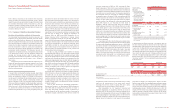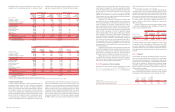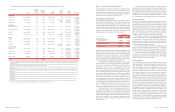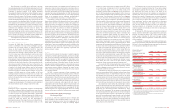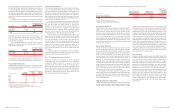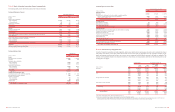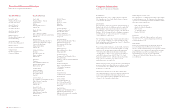Bank of America 2003 Annual Report Download - page 50
Download and view the complete annual report
Please find page 50 of the 2003 Bank of America annual report below. You can navigate through the pages in the report by either clicking on the pages listed below, or by using the keyword search tool below to find specific information within the annual report.
96 BANK OF AMERICA 2003
Note 13 Commitments and Contingencies
In the normal course of business, the Corporation enters into a num-
ber of off-balance sheet commitments. These commitments expose
the Corporation to varying degrees of credit and market risk and are
subject to the same credit and market risk limitation reviews as
those recorded on the Corporation’s balance sheet.
Credit Extension Commitments
The Corporation enters into commitments to extend credit such as
loan commitments, standby letters of credit (SBLCs) and commercial
letters of credit to meet the financing needs of its customers. The
unfunded lending commitments shown in the following table have
been reduced by amounts participated to other financial institutions
of $10.4 billion and $10.2 billion at December 31, 2003 and 2002,
respectively. The following table summarizes outstanding unfunded
lending commitments at December 31, 2003 and 2002.
December 31
(Dollars in millions)
2003 2002
Loan commitments $211,781 $212,704
Standby letters of credit and
financial guarantees 31,150 30,837
Commercial letters of credit 3,260 3,109
Legally binding commitments 246,191 246,650
Credit card lines 93,771 85,801
Total commitments $339,962 $332,451
Legally binding commitments to extend credit generally have speci-
fied rates and maturities. Certain of these commitments have
adverse change clauses that help to protect the Corporation against
deterioration in the borrowers’ ability to pay. Loan commitments
include equity commitments of approximately $1.7 billion and $2.2
billion at December 31, 2003 and 2002, respectively, which primarily
relate to obligations to fund existing equity investments.
The Corporation issues SBLCs and financial guarantees to sup-
port the obligations of its customers to beneficiaries. Additionally, in
many cases, the Corporation holds collateral in various forms against
these SBLCs. As part of its risk management activities, the
Corporation continuously monitors the credit-worthiness of the cus-
tomer as well as SBLC exposure; however, if the customer fails to per-
form the specified obligation to the beneficiary, the beneficiary may
draw upon the SBLC by presenting documents that are in compliance
with the letter of credit terms. In that event, the Corporation either
repays the money borrowed or advanced, makes payment on account
of the indebtedness of the customer or makes payment on account
of the default by the customer in the performance of an obligation, to
the beneficiary up to the full notional amount of the SBLC. The cus-
tomer is obligated to reimburse the Corporation for any such pay-
ment. If the customer fails to pay, the Corporation would, as
contractually permitted, liquidate collateral and/or set off accounts.
Commercial letters of credit, issued primarily to facilitate cus-
tomer trade finance activities, are usually collateralized by the under-
lying goods being shipped to the customer and are generally
short-term. Credit card lines are unsecured commitments that are not
legally binding. Management reviews credit card lines at least annu-
ally, and upon evaluation of the customers’ creditworthiness, the
Corporation has the right to terminate or change certain terms of the
credit card lines.
The Corporation uses various techniques to manage risk associ-
ated with these types of instruments that include collateral and/or
adjusting commitment amounts based on the borrower’s financial con-
dition; therefore, the total commitment amount does not necessarily
represent the actual risk of loss or future cash requirements. For each
of these types of instruments, the Corporation’s exposure to credit
loss is represented by the contractual amount of these instruments.
Other Commitments
When-issued securities are commitments to purchase or sell securi-
ties during the time period between the announcement of a securi-
ties offering and the issuance of those securities. Changes in market
price between commitment date and issuance are reflected in trad-
ing account profits. At December 31, 2003, the Corporation had com-
mitments to purchase and sell when-issued securities of $155.5
billion and $145.8 billion, respectively. At December 31, 2002, the
Corporation had commitments to purchase and sell when-issued
securities of $166.1 billion and $164.5 billion, respectively.
At December 31, 2003 and 2002, charge cards (nonrevolving
card lines) to individuals and government entities guaranteed by the
U.S. government in the amount of $13.7 billion and $52.4 billion,
respectively, were not included in credit card line commitments in the
previous table. The outstandings related to these charge cards were
$233 million and $208 million, respectively.
At December 31, 2003, the Corporation had forward whole mort-
gage loan purchase commitments of $4.6 billion, all of which were
settled in January and February 2004. At December 31, 2003, the
Corporation had no forward whole mortgage loan sale commitments.
The Corporation has entered into operating leases for certain of
its premises and equipment. Commitments under these leases
approximate $1.2 billion per year for each of the years 2004 through
2008 and $3.5 billion for all years thereafter.
Other Guarantees
The Corporation sells products that offer book value protection prima-
rily to plan sponsors of ERISA-governed pension plans such as 401(k)
plans, 457 plans, etc. The book value protection is provided on port-
folios of intermediate/short-term investment grade fixed income secu-
rities and is intended to cover any shortfall in the event that plan
participants withdraw funds when market value is below book value.
The Corporation retains the option to exit the contract at any time. If
the Corporation exercises its option, the purchaser can require the
Corporation to purchase zero coupon bonds with the proceeds of the
liquidated assets to assure the return of principal. To hedge its expo-
sure, the Corporation imposes significant restrictions and constraints
on the timing of the withdrawals, the manner in which the portfolio is
liquidated and the funds are accessed, and the investment parame-
ters of the underlying portfolio. These constraints, combined with
structural protections, are designed to provide adequate buffers and
guard against payments even under extreme stress scenarios. These
guarantees are booked as derivatives and marked to market in the
trading portfolio. At December 31, 2003 and 2002, the notional
amount of these guarantees totaled $24.9 billion and $19.7 billion,
respectively, with estimated maturity dates between 2005 and 2033.
As of December 31, 2003 and 2002, the Corporation has never made
a payment under these products, and management believes that the
probability of payments under these guarantees is remote.
BANK OF AMERICA 2003 97
The following table is a summary of the outstanding Trust Securities and the Notes at December 31, 2003.
(Dollars in millions)
Aggregate Per
Principal Aggregate Annum
Amount of Principal Stated Interest Interest
Issuance Trust Amount of Maturity of Rate of Payment Redemption
Issuer Date Securities the Notes the Notes the Notes Dates Period
NationsBank
Capital Trust II
December 1996 $ 365 $376 December 2026 7.83% 6/15, 12/15 On or after
12/15/06
(1,3)
Capital Trust III
February 1997 494 509 January 2027 3-mo. LIBOR 1/15, 4/15, On or after
+55 bps 7/15, 10/15 1/15/07
(1)
Capital Trust IV
April 1997 498 513 April 2027 8.25 4/15, 10/15 On or after
4/15/07
(1,4)
BankAmerica
Institutional Capital A
November 1996 450 464 December 2026 8.07 6/30, 12/31 On or after
12/31/06
(2,5)
Institutional Capital B
November 1996 300 309 December 2026 7.70 6/30, 12/31 On or after
12/31/06
(2,6)
Capital II
December 1996 450 464 December 2026 8.00 6/15, 12/15 On or after
12/15/06
(2,7)
Capital III
January 1997 400 412 January 2027 3-mo. LIBOR 1/15, 4/15, On or after
+57 bps 7/15, 10/15 1/15/02
(2)
Barnett
Capital I
November 1996 300 309 December 2026 8.06 6/1, 12/1 On or after
12/1/06
(1,8)
Capital II
December 1996 200 206 December 2026 7.95 6/1, 12/1 On or after
12/1/06
(1,9)
Capital III
January 1997 250 258 February 2027 3-mo. LIBOR 2/1, 5/1, On or after
+62.5 bps 8/1, 11/1 2/1/07
(1)
Bank of America
Capital Trust I
December 2001 575 593 December 2031 7.00 3/15, 6/15, On or after
9/15, 12/15 12/15/06
(10)
Capital Trust II
January 2002 900 928 February 2032 7.00 2/1, 5/1, On or after
8/1, 11/1 2/1/07
(10)
Capital Trust III
August 2002 500 516 August 2032 7.00 2/15, 5/15, On or after
8/15, 11/15 8/15/07
(10)
Capital Trust IV
April 2003 375 387 May 2033 5.88 2/1, 5/1, On or after
8/1, 11/1 5/1/08
(10)
Total
$6,057 $6,244
(1) The Corporation may redeem the Notes prior to the indicated redemption period upon the occurrence of certain events relating to tax treatment of the related trust or the Notes, relating to capital treat-
ment of the Trust Securities or relating to a change in the treatment of the related trust under the Investment Company Act of 1940, as amended, at a redemption price at least equal to the principal
amount of the Notes.
(2) The Corporation may redeem the Notes prior to the indicated redemption period upon the occurrence of certain events relating to tax treatment of the related trust or the Notes or relating to capital
treatment of the Trust Securities at a redemption price at least equal to the principal amount of the Notes.
(3) The Notes may be redeemed on or after December 15, 2006 and prior to December 15, 2007 at 103.915% of the principal amount, and thereafter at prices declining to 100% on December 15, 2016
and thereafter.
(4) The Notes may be redeemed on or after April 15, 2007 and prior to April 14, 2008 at 103.85% of the principal amount, and thereafter at prices declining to 100% on April 15, 2017 and thereafter.
(5) The Notes may be redeemed on or after December 31, 2006 and prior to December 31, 2007 at 104.035% of the principal amount, and thereafter at prices declining to 100% on December 31, 2016
and thereafter.
(6) The Notes may be redeemed on or after December 31, 2006 and prior to December 31, 2007 at 103.779% of the principal amount, and thereafter at prices declining to 100% on December 31, 2016
and thereafter.
(7) The Notes may be redeemed on or after December 15, 2006 and prior to December 15, 2007 at 103.969% of the principal amount, and thereafter at prices declining to 100% on December 15, 2016
and thereafter.
(8) The Notes may be redeemed on or after December 1, 2006 and prior to December 1, 2007 at 104.03% of the principal amount, and thereafter at prices declining to 100% on December 1, 2016
and thereafter.
(9) The Notes may be redeemed on or after December 1, 2006 and prior to December 1, 2007 at 103.975% of the principal amount, and thereafter at prices declining to 100% on December 1, 2016
and thereafter.
(10) The Corporation may redeem the Notes prior to the indicated redemption period upon the occurrence and continuation of a tax event, an investment company event or a capital treatment event.
The Corporation may extend the stated maturity date of the junior subordinated notes to a date no later than May 23, 2052.



